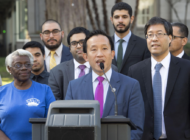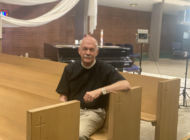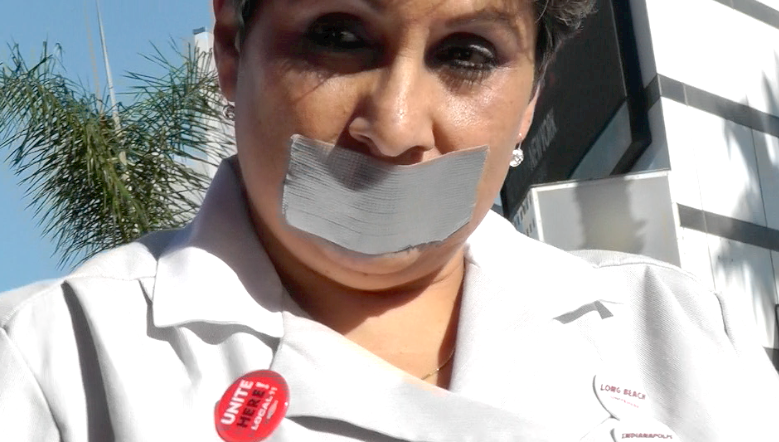By PAUL MAVERICK
POLITICAL MUSCLE
Dining Hall workers and their supporters among students, alumni, and faculty held a picket and rally at Pomona College in Claremont, California, outside the college administration building on Wednesday, August 3, 2011. A crowd of approximately one hundred gathered to protest the firing of Francisco Garcia, a cook with sixteen years’ experience at Pomona College, whom the protestors claim was terminated because of his involvement with union organizing on campus.
Beyond the details of Garcia’s plight, the event included accusations of further unfair labor practices, conflicting views on the proper way for workers to unionize, and – beneath the surface – an unarticulated critique of President Obama’s effectiveness, implicit in the nature of the confrontation.
(The full story continues below the video.)
Francisco Covarrubias, a Pomona College graduate from the class of 2010, asserted that Pomona College management fired Garcia, “because he was one of the leaders of the Workers for Justice movement. Management believes if they can get rid of the leaders, the movement will topple.” Pomona College Vice-President and Treasurer Karen Sisson, however, denied the allegation, saying, “Because of privacy concerns for the employee, we cannot divulge the specific circumstances of this employee’s termination, but we can confirm that it in no way had anything to do with that employee’s activities for or against unionization.”
Garcia, the cook who was fired, took part in a delegation which marched on Vice-President Sisson’s office, and he presented her with a letter requesting his reinstatement. “I was fired unjustly after I was injured,” Garcia said to the crowd outside the administration building. “They treat us like we are garbage that they can throw away.” Rolando Arias, who has worked as a cook at Pomona College for six years, added, “I plan to work here for a long time. How can I be secure when I have to worry if I will still have a job if I get injured? Once we get a democratic process to vote for a union, these kinds of things are going to stop.”
Arias’s remarks point to the larger question, involving which process workers will use when voting on whether or not to form a union. Vice-President Sisson stated that Pomona College, “has always supported the right of workers to unionize. The issue has been how that election is going to take place. The college has always had the position of using the existing legal process of an NLRB election.”
The acronym “NLRB” refers to the National Labor Relations Board, which was established in 1935 during the presidency of Franklin Roosevelt. The Board oversees elections to decide whether or not workers at a given workplace will be represented by a union. There are several ways this can happen. One is, as Sisson suggested, an NLRB election. She referred to this several times as a “secret ballot” election, while Pomona College student Sarah Appelbaum pointed out, “It’s not really an anonymous process when you have to hand your ballot – saying whether or not you support a union – to your boss.”
In addition, Christian Torres – a Pomona College cook with six years on the job – said that the NLRB process allows for “the employers to intimidate the workers, and to hire union-busters,” outside consultants who hold meetings and talk with workers specifically to undermine support for a union. Vice-President Sisson responded that the college is “an institution that values free speech,” and it has the right to “talk about its values and its plans for these workers.”
Sisson was emphatic, “The NLRB is the only legal way to be legally recognized.” However, she quickly backed away from this, adding, “I guess the NLRB will now sanction ‘card-check,’ but there are some issues around that.” This was a mischaracterization, as the NLRB has recognized card-check – also referred to as “majority sign-up” – since 1935, as a valid means for workers to form a union.
Sisson was correct, however, in saying there are some issues around the card-check process. One of the issues is that, as student Appelbaum stated, “Card-check uses a third party, so it is anonymous. The school doesn’t have to see the names; it can just hear the result through the third party.” From the administration’s standpoint, that could very well be an issue. A more central problem with majority sign-up, however, is that the process is voluntary for the employer. That is, even if a majority of workers indicate their preference for a union, the employer is not required to recognize the result, and can demand an additional vote be held, under the NLRB conditions.
Researchers at the University of California, Berkeley’s Center for Labor Research and Education have studied the NLRB election process, and in June of 2011, they released findings which say the process “fails to ensure that workers can freely form unions.” The researchers conclude, “To the detriment of workers, the NLRB’s election procedures have created inequalities and unfairness over the timing of elections, and allowed the process to be plagued with unfair labor practices.”
Despite this, the dining hall workers, in a recent round of negotiations, agreed to drop the majority sign-up process, and follow the NLRB process to run their election, if the college would be willing to remain neutral, and refrain from making anti-union statements. The administration refused. The cook Christian Torres described why neutrality is important to the workers: “In one of the negotiation meetings, the administration agreed to tell the managers to keep neutral. The next thing that happened, the general manager came to me, took me to his office, and started to talk with me about the union – saying the union would not get me a better raise, the union won’t fight for me. When that happened, I went to the president. He said he would investigate.” When the manager denied Torres’s claim, “They believed the manager. They said I called the meeting, and it was about my schedule. That’s why we want the college to be neutral. We can’t trust them anymore.”
Hanging over this local labor battle about 70 dining hall workers at a small private college in California is the shadow of presidential politics. A bill was first introduced to Congress in 2007, known as the Employee Free Choice Act (EFCA), the essence of which was to establish the majority sign-up as sufficient grounds to unionize a given workplace, thereby ending the ability of employers to force additional balloting. Then-Senator Barack Obama was an original co-sponsor of this bill, and while it cleared the House and had majority support in the Senate, it died before passage, because supporters could not gather 60 votes in the Senate in order to overcome a Republican filibuster. During Obama’s campaign for the presidency, he made passage of the Employee Free Choice Act his central promise to the labor movement, which mobilized heavily on his behalf. In April of 2008, Obama said, “I will make it the law of the land when I am president of the United States.”
Following his victory, Obama found himself with 60 Democratic senators in 2009, enough to overcome a Republican filibuster. Yet President Obama did not get the Employee Free Choice Act through Congress, despite the fact that his predecessor passed several controversial bills through the Senate with well under 60 votes. In any case, the Democrats lost control of the House after the 2010 midterm elections, thereby eliminating any chance of EFCA’s passage. The dining hall workers of Pomona College, over 90 percent of whom petitioned the college for union recognition in March of 2010, would have had their union, if Obama had followed through on his promise.
Even without the passage of EFCA, however, workers have shown the ability to win union recognition, under the lopsided NLRB rules. In July of this year, workers at IKEA’s sole U.S. manufacturing plant, in Danville, Virginia overwhelmingly voted in favor of joining the International Association of Machinists and Aerospace Workers. They did so while using the NLRB process.
What is the way forward at Pomona College? Given that over 90 percent of dining hall workers have expressed their desire for a union, the school administration could recognize this any time they like, through majority sign-up, and the struggle would be over. Or management could agree to neutrality, and let the election process go forward under NLRB methods, as the employees have conceded. On the other side, workers could submit to running the gauntlet of the full NLRB process, without demanding neutrality from the employer – which Vice-President Sisson calls “a gag order” on the college’s ability to speak – as a means of proving the strength of their convictions.
One side will have to give way. For the moment, however, both parties appear dug in. Vice-President Sisson stated, “We will respect the results of an NLRB election.” For his part, the cook Torres replied, “We’re waiting for them to be ready to be neutral, and call us back to the negotiating table.”
Tags: afl California campus card check christian torres claremont college dining hall Education efca employee free choice act food service francisco covarrubias francisco garcia karen sisson labor marcha national labor relations board nlrb obama Political Muscle pomona college president obama protest Protesta rolando arias sarah appelbaum school secret ballot student unfair labor practices union workers for justice




















